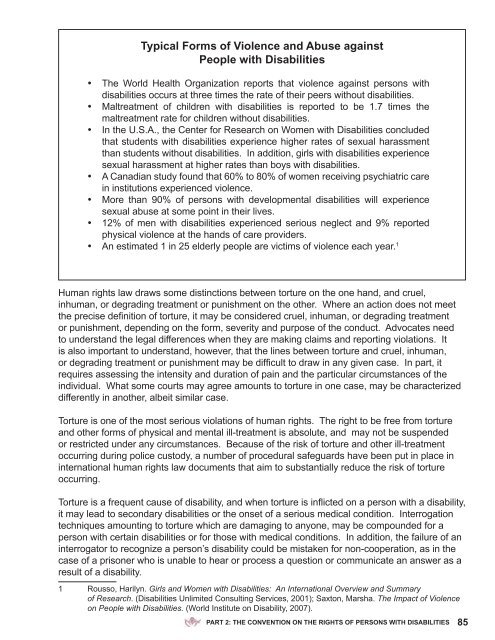Full page photo print - Harvard Law School Project on Disability
Full page photo print - Harvard Law School Project on Disability
Full page photo print - Harvard Law School Project on Disability
You also want an ePaper? Increase the reach of your titles
YUMPU automatically turns print PDFs into web optimized ePapers that Google loves.
typical forms of Violence and abuse against<br />
people with disabilities<br />
• The World Health Organizati<strong>on</strong> reports that violence against pers<strong>on</strong>s with<br />
disabilities occurs at three times the rate of their peers without disabilities.<br />
• Maltreatment of children with disabilities is reported to be 1.7 times the<br />
maltreatment rate for children without disabilities.<br />
• In the U.S.A., the Center for Research <strong>on</strong> Women with Disabilities c<strong>on</strong>cluded<br />
that students with disabilities experience higher rates of sexual harassment<br />
than students without disabilities. In additi<strong>on</strong>, girls with disabilities experience<br />
sexual harassment at higher rates than boys with disabilities.<br />
• A Canadian study found that 60% to 80% of women receiving psychiatric care<br />
in instituti<strong>on</strong>s experienced violence.<br />
• More than 90% of pers<strong>on</strong>s with developmental disabilities will experience<br />
sexual abuse at some point in their lives.<br />
• 12% of men with disabilities experienced serious neglect and 9% reported<br />
physical violence at the hands of care providers.<br />
• An estimated 1 in 25 elderly people are victims of violence each year. 1<br />
Human rights law draws some distincti<strong>on</strong>s between torture <strong>on</strong> the <strong>on</strong>e hand, and cruel,<br />
inhuman, or degrading treatment or punishment <strong>on</strong> the other. Where an acti<strong>on</strong> does not meet<br />
the precise definiti<strong>on</strong> of torture, it may be c<strong>on</strong>sidered cruel, inhuman, or degrading treatment<br />
or punishment, depending <strong>on</strong> the form, severity and purpose of the c<strong>on</strong>duct. Advocates need<br />
to understand the legal differences when they are making claims and reporting violati<strong>on</strong>s. It<br />
is also important to understand, however, that the lines between torture and cruel, inhuman,<br />
or degrading treatment or punishment may be difficult to draw in any given case. In part, it<br />
requires assessing the intensity and durati<strong>on</strong> of pain and the particular circumstances of the<br />
individual. What some courts may agree amounts to torture in <strong>on</strong>e case, may be characterized<br />
differently in another, albeit similar case.<br />
Torture is <strong>on</strong>e of the most serious violati<strong>on</strong>s of human rights. The right to be free from torture<br />
and other forms of physical and mental ill-treatment is absolute, and may not be suspended<br />
or restricted under any circumstances. Because of the risk of torture and other ill-treatment<br />
occurring during police custody, a number of procedural safeguards have been put in place in<br />
internati<strong>on</strong>al human rights law documents that aim to substantially reduce the risk of torture<br />
occurring.<br />
Torture is a frequent cause of disability, and when torture is inflicted <strong>on</strong> a pers<strong>on</strong> with a disability,<br />
it may lead to sec<strong>on</strong>dary disabilities or the <strong>on</strong>set of a serious medical c<strong>on</strong>diti<strong>on</strong>. Interrogati<strong>on</strong><br />
techniques amounting to torture which are damaging to any<strong>on</strong>e, may be compounded for a<br />
pers<strong>on</strong> with certain disabilities or for those with medical c<strong>on</strong>diti<strong>on</strong>s. In additi<strong>on</strong>, the failure of an<br />
interrogator to recognize a pers<strong>on</strong>’s disability could be mistaken for n<strong>on</strong>-cooperati<strong>on</strong>, as in the<br />
case of a pris<strong>on</strong>er who is unable to hear or process a questi<strong>on</strong> or communicate an answer as a<br />
result of a disability.<br />
1 Rousso, Harilyn. Girls and Women with Disabilities: An Internati<strong>on</strong>al Overview and Summary<br />
of Research. (Disabilities Unlimited C<strong>on</strong>sulting Services, 2001); Saxt<strong>on</strong>, Marsha. The Impact of Violence<br />
<strong>on</strong> People with Disabilities. (World Institute <strong>on</strong> <strong>Disability</strong>, 2007).<br />
part 2: the COnVentiOn On the rights Of persOns with disabilities<br />
85




